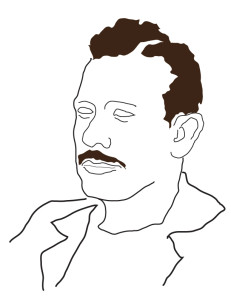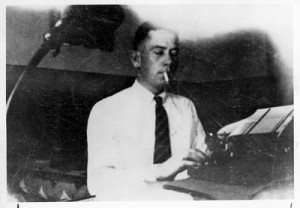In 1925, during the sixth and final year of John Steinbeck’s time as a Stanford student, the soon-to-be famous author moved off campus to a one-room shack behind a larger house in Palo Alto. The room was seven square feet and Steinbeck loved it.

“Steinbeck called the shack ‘the Den of Pegasus’ after the mythological flying horse because it symbolized [his and his writer friends’] soaring ambitions,” said Art Ring, a former Steinbeck Collector’s Club member. An avid Steinbeck enthusiast, Ring used to lead tours across the Stanford campus that detailed Steinbeck’s life at the University.
“Several years later, Steinbeck changed the symbol to a winged pig, explaining…‘I find I’m more a Pigasus than a Pegasus; a lumbering soul but trying to fly,’” Ring said. “To Steinbeck, that summed up the progress of his career at that point in his life…Steinbeck used that symbol throughout his life. This is the Steinbeck persona.”
Steinbeck had a colorful career at Stanford. In the six years that he was enrolled at the University, starting in 1919, he only accumulated 93 units — becoming equivalent in status to a junior.
“He came to Stanford to mollify his parents, primarily his mother,” explained Kevin Hearle ’80, a visiting scholar at the Bill Lane Center for the American West. “He wasn’t excited about it. He didn’t see why he needed a college education to be a writer.”
Steinbeck had no intention of graduating, according to Ring. Instead, the future Pulitzer- and Nobel-prize winning author took a collection of courses that he thought would help him hone his craft as a writer. His grades were far from stellar, and he often withdrew from classes before the final if he found them uninteresting.
Despite his varied college career, he did meet two English professors who he came to respect greatly. Margery Bailey ’14 M.A. ’16 and Edith Mirrielees ’07 would have a formative impact on Steinbeck’s writing.
Mirrielees taught a class on the short story, a form of literature in which Steinbeck would become a heralded voice.
“Edith Mirrielees was the first to spot Steinbeck’s talent,” Ring said. “She restored his ego, and gently and quietly would fire him with hope.”
“In terms of his actual education and what he got out of it…at first he probably didn’t get much,” Hearle said. “But he eventually found a group of fairly like-minded guys who were interested in writing and who knew that they wanted to be writers.
“Some of his best friends over the years — people he kept in touch with his entire life — were Stanford guys,” he added.
One such man was Carlton Sheffield ’23 M.A. ’30, affectionately known to Steinbeck as Dook. Dook would become Steinbeck’s lifelong companion until the latter’s death in 1968. Along with filling the role of best man at Steinbeck’s wedding to first wife Carol Henning, Dook also once saved Steinbeck’s life during a camping trip.
Another was Ed Ricketts, a man who would later be immortalized as “Doc” in Cannery Row. Rickets and Steinbeck later wrote “The Log from the Sea of Cortez,” a description of their trip to the Gulf of California.
Steinbeck met Ricketts at the Hopkins Marine Station, Stanford’s marine laboratory, during a summer session.
According to Hearle, Steinbeck’s time at the station in Pacific Grove was pivotal to his work as an author and granted him as awareness of biological and ecological systems.
“He wound up becoming probably the most scientifically, especially biologically trained major American novelist of his time,” Hearle noted. “The Hopkins Marine Lab also gave Steinbeck an ecological perspective.”
“Almost all of his works begin with looking first at the setting, at the environment…because of his notion that people are part of an environment,” he added. “That aspect of humans as animals and humans as part of an ecosystem is central to Steinbeck’s understanding of the world.”
In 1925, Steinbeck left Stanford to pursue a writing career in New York with neither a diploma nor an intent to return. Although he remained close to several teachers and friends he had met in Pacific Grove and Palo Alto, he did not keep up a relationship with the University.
In a 1964 letter to his good friend Dook, Steinbeck asked, “Do you ever go near Stanford? I don’t think I would like to go. It would be kind of embarrassing because I was such a lousy student, I suppose. Anyway, I have no call for the Groves of Academe.”
The Groves of Academe, however, had housed him well in some regards. In a 1962 letter to Mirrielees, he wrote about her influence on his writing.
“Although it must be a thousand years ago that I sat in your class in story writing at Stanford, I remember the experience very clearly,” Steinbeck said. “I was bright-eyed and bushy-brained and prepared to absorb from you the secret formula for writing good short stories, even great short stories. You canceled this illusion very quickly.”

-Taylor Grossman
1964 letter from Sandstone & Tile, Winter/Spring 2002 publication. Citation: John Steinbeck to Carlton Sheffield. June 21, 1964, Sag Harbor, Long Island, New York. Steinbeck Collection
